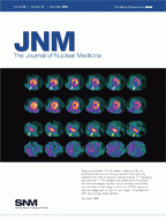TO THE EDITOR: Intraductal papillary mucinous neoplasms (IPMNs) of the pancreas are tumors characterized by the intraductal proliferation of neoplastic mucinous cells in the main pancreatic duct or its major branches (1,2). IPMNs are classified as noninvasive or invasive, and noninvasive IPMNs are further divided into 3 groups, based on the degree of cytologic and architectural dysplasia, that is, IPMN with low-grade dysplasia (LG-D) (or intraductal papillary mucinous adenoma), IPMN with moderate dysplasia (MG-D) (replacing the old term, IPMN-borderline), and IPMN with high-grade dysplasia (HG-D) (or intraductal papillary mucinous carcinoma in situ). Appropriate clinical and surgical management of these neoplasms requires accurate differentiation between premalignancies (LG-D and MG-D IPMNs) and malignancies (HG-D IPMN and invasive carcinoma). In recent years, 18F-FDG PET has been increasingly used in the diagnosis, staging, and posttreatment surveillance of many types of malignancy. Our group has already reported on the role of 18F-FDG PET in discriminating between malignant and benign IPMNs (3).
A higher 18F-FDG uptake rate has been found to correlate with a greater expression of glucose transporter-1 (GLUT-1) in tumor cells than in normal pancreatic tissue (4–7). Moreover, an increased GLUT-1 expression has proved to be a negative prognostic factor in pancreatic ductal adenocarcinomas (8) and has been associated in vitro with pancreatic cancer cell invasiveness (9). We decided to investigate the biologic and prognostic significance of GLUT-1 expression and its relationship with radiologic findings in our series of IPMNs.
From July 2002 to March 2008, 22 patients with IPMN of the pancreas underwent pancreatic resection at the Department of Medical and Surgical Sciences of the University of Padova. Among them, 16 patients underwent 18F-FDG PET in addition to conventional imaging techniques. 18F-FDG PET images were obtained as described elsewhere (3). The patients included 18 men and 4 women, with a mean age of 68 y (range, 47–81 y). None of the patients received preoperative chemotherapy or radiation therapy.
Six IPMNs were histologically classified as benign (2 LG-D and 4 MG-D), and 16 as malignant (5 HG-D and 11 invasive carcinomas). The mean tumor diameter was 2.9 cm (range, 0.7–4.5 cm). According to their mucin expression profiles (MUC1, MUC2, and MUC5AC) (2), 14 of the IPMNs were classified as pancreatobiliary type (including all the invasive cancers), 5 as intestinal type, and 3 as gastric type. The MIB-1 labeling index correlated with the malignant behavior of the tumors (LG-D MIB-1 labeling index = 1.0 ± 0.2, MG-D = 2.3 ± 1.4, HG-D = 5.7 ± 3.3, invasive cancers = 25.0 ± 7.4; P = 0.003, Kruskal–Wallis nonparametric test for trend).
GLUT-1 expression was considered positive only when a distinct plasma membrane staining was evident in more than 5% of neoplastic cells. Two different representative tumor sections were assessed for each case. GLUT-1 immunoreactivity was detected in all cases of invasive carcinoma and in 3 of 5 cases of HG-D IPMN; no immunoreactivity was observed in benign tumors. In all cases of invasive carcinoma, the invasive component of the neoplasm showed a more intense and accentuated GLUT-1 immunoreactivity than did the intraductal counterpart. Intratumoral 18F-FDG distribution coincides well with GLUT-1 expression levels (10). We can thus speculate that the invasive component is responsible for the highest intratumoral 18F-FDG accumulation, significantly affecting the standardized uptake values.
No increase in glucose uptake was detected by 18F-FDG PET in patients with a diagnosis of LG-D (n = 2) or MG-D (n = 3) IPMN, whereas a significant increase in glucose uptake (standardized uptake value ≥ 2.5) was observed in 4 of 5 patients with HG-D IPMN and in 4 of 6 with invasive carcinomas, confirming our previous report (3). As previously observed (6), tumor size did not significantly affect standardized uptake values. What is more, all but 1 of the 8 18F-FDG PET–positive tumors were immunohistochemically positive for GLUT-1.
Our findings strongly support a GLUT-1 overexpression and a direct relationship between GLUT-1 expression and 18F-FDG PET positivity in malignant pancreatic IPMNs. Further prospective studies on larger series are needed to validate GLUT-1 expression as a diagnostic and prognostic tool in IPMNs of the pancreas.
Footnotes
-
COPYRIGHT © 2008 by the Society of Nuclear Medicine, Inc.







